CHC33015 Certificate III Individual Support Assessment Workbook V1.2
VerifiedAdded on 2023/06/18
|48
|8429
|480
Homework Assignment
AI Summary
This document is an assessment workbook for the CHC33015 Certificate III in Individual Support, version 1.2. It includes instructions, information on competency-based assessment, principles of assessment, dimensions of competency, and reasonable adjustment. The workbook covers units of competency CHCCCS025 (Support relationships with carers and families) and CHCHCS001 (Provide home and community support services), detailing assessment requirements, performance evidence, and knowledge evidence. Assessment methods include written questions and case studies. The document also provides a checklist and feedback section for students. Desklib provides access to this and other solved assignments for students.
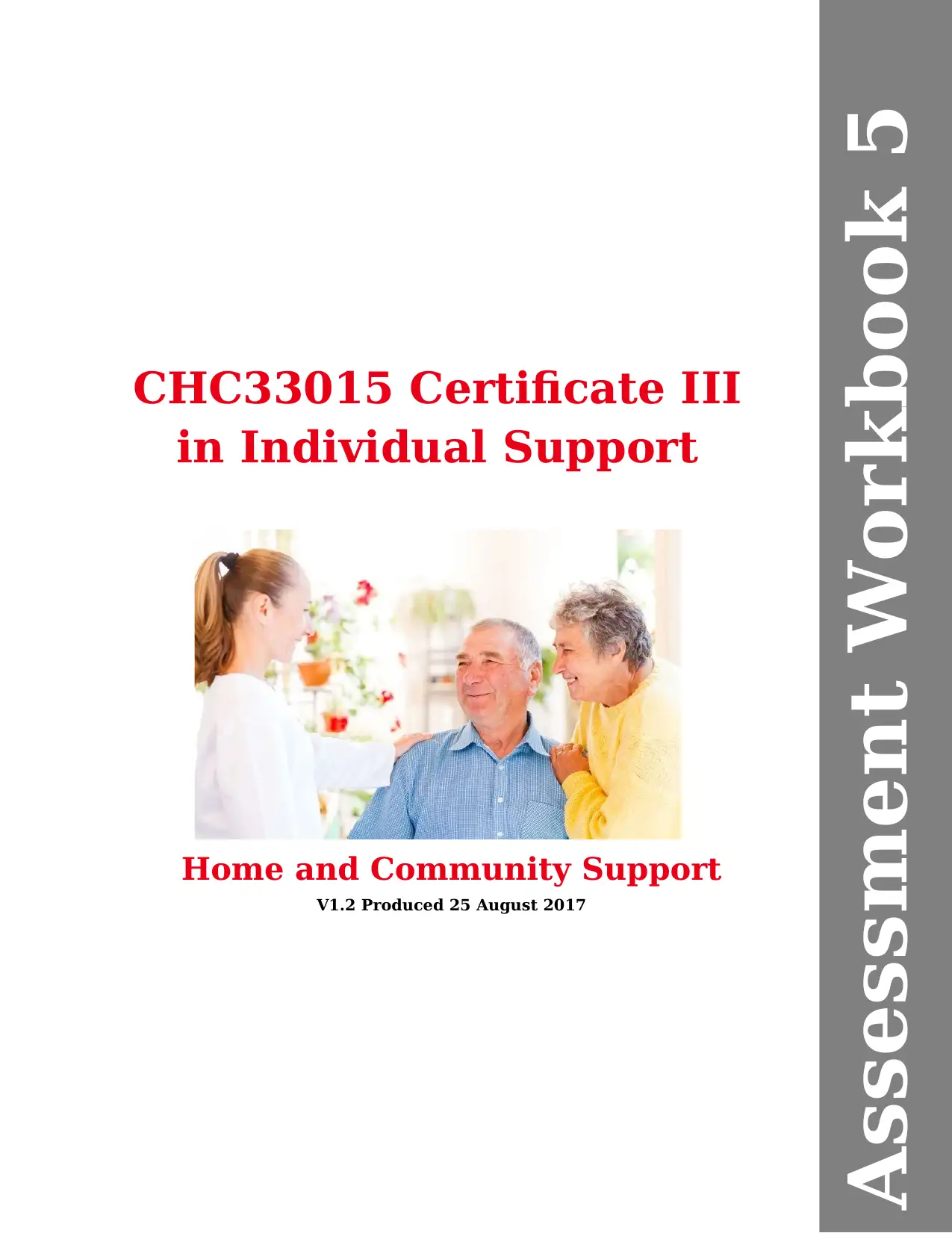
CHC33015 Certificate III
in Individual Support
Home and Community Support
V1.2 Produced 25 August 2017
Assessment Workbook 5
in Individual Support
Home and Community Support
V1.2 Produced 25 August 2017
Assessment Workbook 5
Paraphrase This Document
Need a fresh take? Get an instant paraphrase of this document with our AI Paraphraser
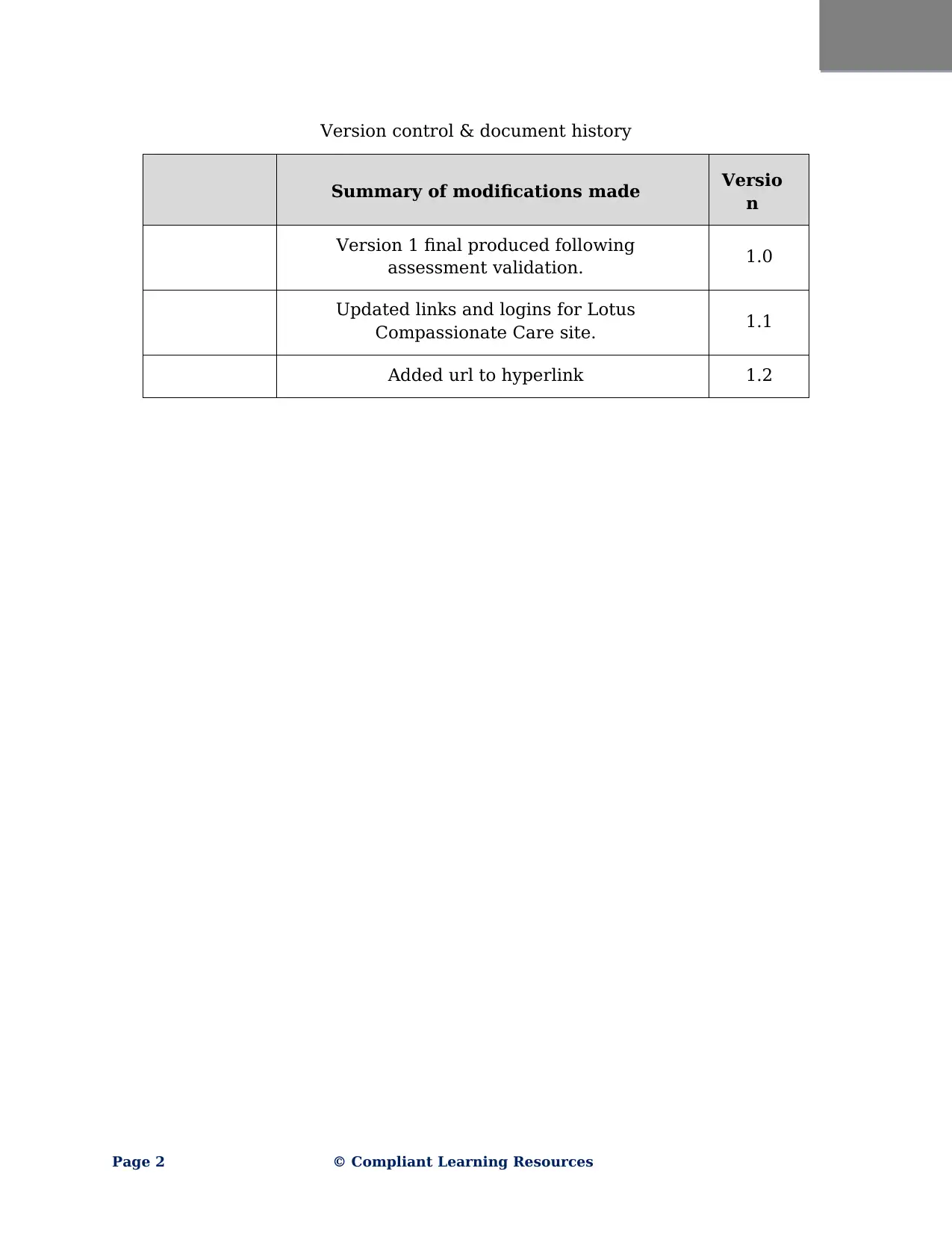
Version control & document history
Summary of modifications made Versio
n
Version 1 final produced following
assessment validation. 1.0
Updated links and logins for Lotus
Compassionate Care site. 1.1
Added url to hyperlink 1.2
Page 2 © Compliant Learning Resources
Summary of modifications made Versio
n
Version 1 final produced following
assessment validation. 1.0
Updated links and logins for Lotus
Compassionate Care site. 1.1
Added url to hyperlink 1.2
Page 2 © Compliant Learning Resources
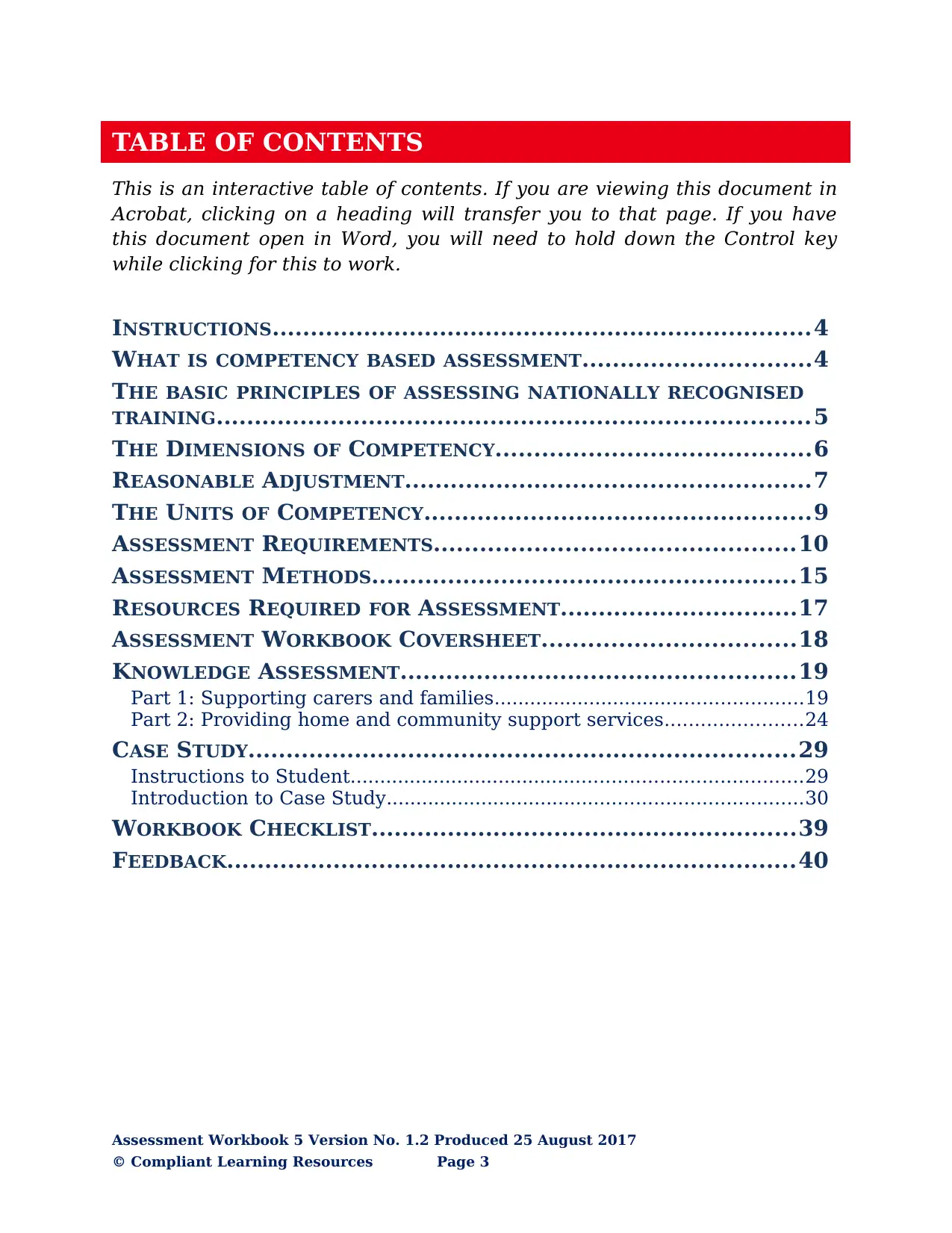
TABLE OF CONTENTS
This is an interactive table of contents. If you are viewing this document in
Acrobat, clicking on a heading will transfer you to that page. If you have
this document open in Word, you will need to hold down the Control key
while clicking for this to work.
INSTRUCTIONS.......................................................................4
WHAT IS COMPETENCY BASED ASSESSMENT..............................4
THE BASIC PRINCIPLES OF ASSESSING NATIONALLY RECOGNISED
TRAINING..............................................................................5
THE DIMENSIONS OF COMPETENCY.........................................6
REASONABLE ADJUSTMENT.....................................................7
THE UNITS OF COMPETENCY...................................................9
ASSESSMENT REQUIREMENTS...............................................10
ASSESSMENT METHODS........................................................15
RESOURCES REQUIRED FOR ASSESSMENT...............................17
ASSESSMENT WORKBOOK COVERSHEET.................................18
KNOWLEDGE ASSESSMENT....................................................19
Part 1: Supporting carers and families....................................................19
Part 2: Providing home and community support services.......................24
CASE STUDY........................................................................29
Instructions to Student............................................................................29
Introduction to Case Study......................................................................30
WORKBOOK CHECKLIST........................................................39
FEEDBACK...........................................................................40
Assessment Workbook 5 Version No. 1.2 Produced 25 August 2017
© Compliant Learning Resources Page 3
This is an interactive table of contents. If you are viewing this document in
Acrobat, clicking on a heading will transfer you to that page. If you have
this document open in Word, you will need to hold down the Control key
while clicking for this to work.
INSTRUCTIONS.......................................................................4
WHAT IS COMPETENCY BASED ASSESSMENT..............................4
THE BASIC PRINCIPLES OF ASSESSING NATIONALLY RECOGNISED
TRAINING..............................................................................5
THE DIMENSIONS OF COMPETENCY.........................................6
REASONABLE ADJUSTMENT.....................................................7
THE UNITS OF COMPETENCY...................................................9
ASSESSMENT REQUIREMENTS...............................................10
ASSESSMENT METHODS........................................................15
RESOURCES REQUIRED FOR ASSESSMENT...............................17
ASSESSMENT WORKBOOK COVERSHEET.................................18
KNOWLEDGE ASSESSMENT....................................................19
Part 1: Supporting carers and families....................................................19
Part 2: Providing home and community support services.......................24
CASE STUDY........................................................................29
Instructions to Student............................................................................29
Introduction to Case Study......................................................................30
WORKBOOK CHECKLIST........................................................39
FEEDBACK...........................................................................40
Assessment Workbook 5 Version No. 1.2 Produced 25 August 2017
© Compliant Learning Resources Page 3
⊘ This is a preview!⊘
Do you want full access?
Subscribe today to unlock all pages.

Trusted by 1+ million students worldwide
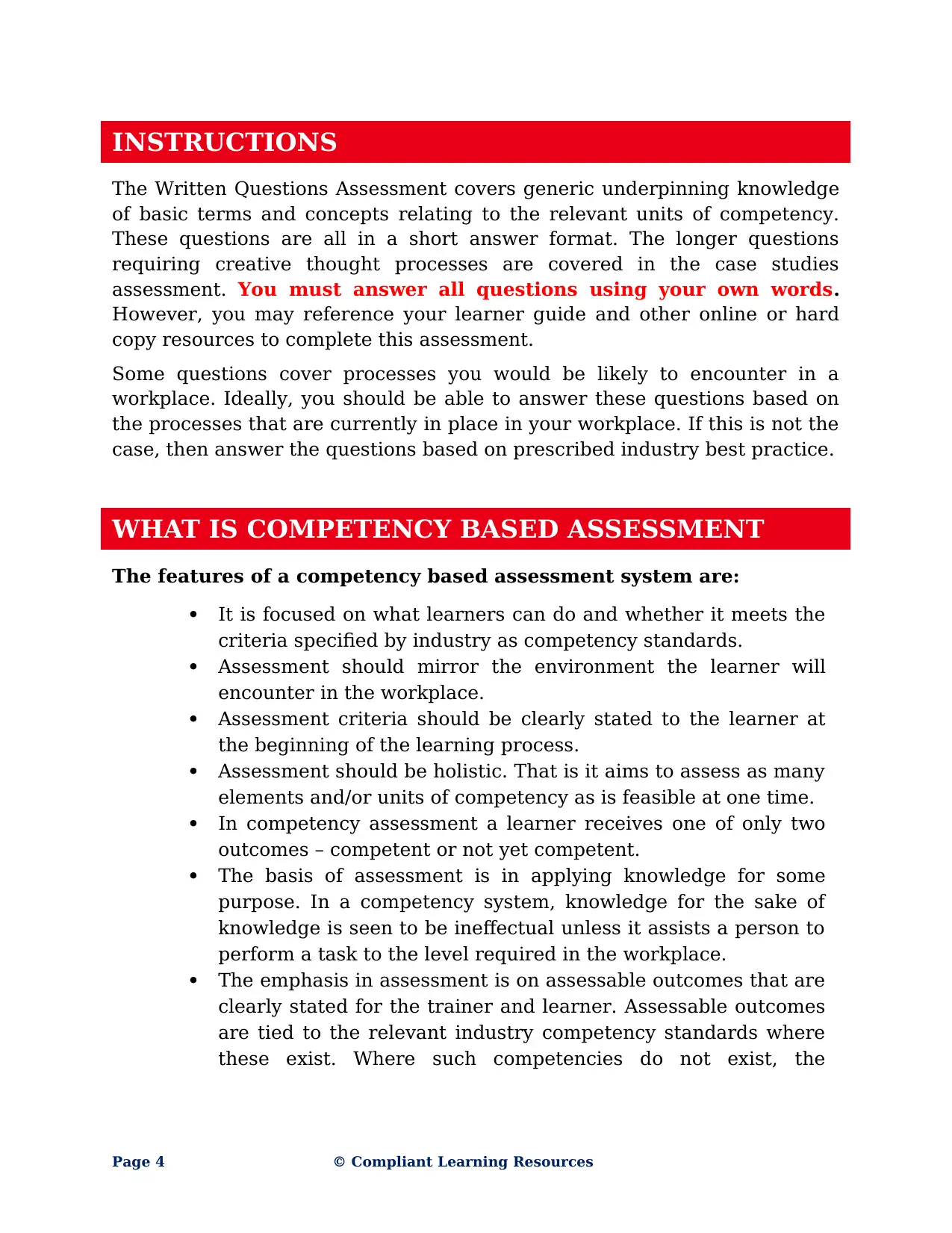
INSTRUCTIONS
The Written Questions Assessment covers generic underpinning knowledge
of basic terms and concepts relating to the relevant units of competency.
These questions are all in a short answer format. The longer questions
requiring creative thought processes are covered in the case studies
assessment. You must answer all questions using your own words.
However, you may reference your learner guide and other online or hard
copy resources to complete this assessment.
Some questions cover processes you would be likely to encounter in a
workplace. Ideally, you should be able to answer these questions based on
the processes that are currently in place in your workplace. If this is not the
case, then answer the questions based on prescribed industry best practice.
WHAT IS COMPETENCY BASED ASSESSMENT
The features of a competency based assessment system are:
It is focused on what learners can do and whether it meets the
criteria specified by industry as competency standards.
Assessment should mirror the environment the learner will
encounter in the workplace.
Assessment criteria should be clearly stated to the learner at
the beginning of the learning process.
Assessment should be holistic. That is it aims to assess as many
elements and/or units of competency as is feasible at one time.
In competency assessment a learner receives one of only two
outcomes – competent or not yet competent.
The basis of assessment is in applying knowledge for some
purpose. In a competency system, knowledge for the sake of
knowledge is seen to be ineffectual unless it assists a person to
perform a task to the level required in the workplace.
The emphasis in assessment is on assessable outcomes that are
clearly stated for the trainer and learner. Assessable outcomes
are tied to the relevant industry competency standards where
these exist. Where such competencies do not exist, the
Page 4 © Compliant Learning Resources
The Written Questions Assessment covers generic underpinning knowledge
of basic terms and concepts relating to the relevant units of competency.
These questions are all in a short answer format. The longer questions
requiring creative thought processes are covered in the case studies
assessment. You must answer all questions using your own words.
However, you may reference your learner guide and other online or hard
copy resources to complete this assessment.
Some questions cover processes you would be likely to encounter in a
workplace. Ideally, you should be able to answer these questions based on
the processes that are currently in place in your workplace. If this is not the
case, then answer the questions based on prescribed industry best practice.
WHAT IS COMPETENCY BASED ASSESSMENT
The features of a competency based assessment system are:
It is focused on what learners can do and whether it meets the
criteria specified by industry as competency standards.
Assessment should mirror the environment the learner will
encounter in the workplace.
Assessment criteria should be clearly stated to the learner at
the beginning of the learning process.
Assessment should be holistic. That is it aims to assess as many
elements and/or units of competency as is feasible at one time.
In competency assessment a learner receives one of only two
outcomes – competent or not yet competent.
The basis of assessment is in applying knowledge for some
purpose. In a competency system, knowledge for the sake of
knowledge is seen to be ineffectual unless it assists a person to
perform a task to the level required in the workplace.
The emphasis in assessment is on assessable outcomes that are
clearly stated for the trainer and learner. Assessable outcomes
are tied to the relevant industry competency standards where
these exist. Where such competencies do not exist, the
Page 4 © Compliant Learning Resources
Paraphrase This Document
Need a fresh take? Get an instant paraphrase of this document with our AI Paraphraser
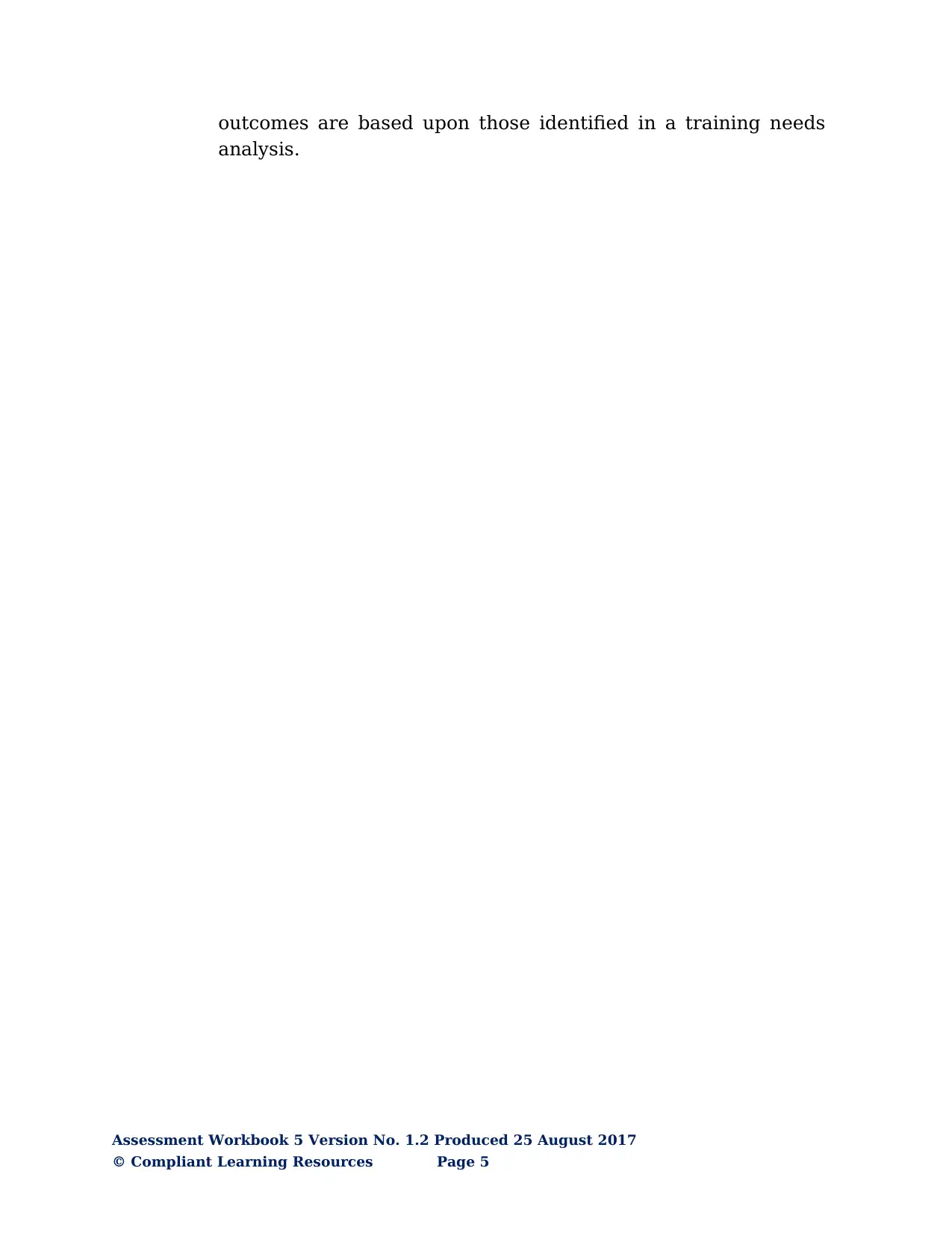
outcomes are based upon those identified in a training needs
analysis.
Assessment Workbook 5 Version No. 1.2 Produced 25 August 2017
© Compliant Learning Resources Page 5
analysis.
Assessment Workbook 5 Version No. 1.2 Produced 25 August 2017
© Compliant Learning Resources Page 5
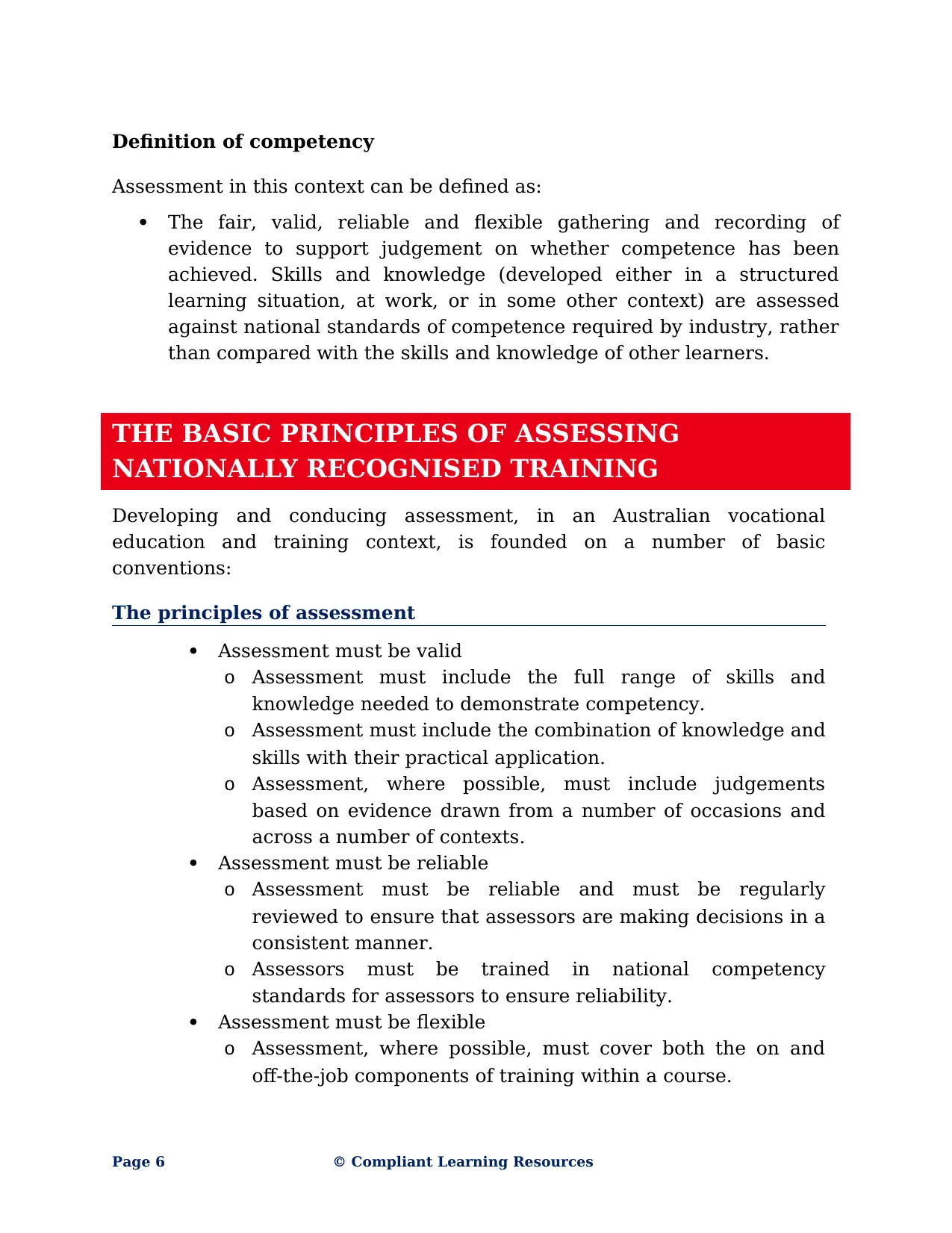
Definition of competency
Assessment in this context can be defined as:
The fair, valid, reliable and flexible gathering and recording of
evidence to support judgement on whether competence has been
achieved. Skills and knowledge (developed either in a structured
learning situation, at work, or in some other context) are assessed
against national standards of competence required by industry, rather
than compared with the skills and knowledge of other learners.
THE BASIC PRINCIPLES OF ASSESSING
NATIONALLY RECOGNISED TRAINING
Developing and conducing assessment, in an Australian vocational
education and training context, is founded on a number of basic
conventions:
The principles of assessment
Assessment must be valid
o Assessment must include the full range of skills and
knowledge needed to demonstrate competency.
o Assessment must include the combination of knowledge and
skills with their practical application.
o Assessment, where possible, must include judgements
based on evidence drawn from a number of occasions and
across a number of contexts.
Assessment must be reliable
o Assessment must be reliable and must be regularly
reviewed to ensure that assessors are making decisions in a
consistent manner.
o Assessors must be trained in national competency
standards for assessors to ensure reliability.
Assessment must be flexible
o Assessment, where possible, must cover both the on and
off-the-job components of training within a course.
Page 6 © Compliant Learning Resources
Assessment in this context can be defined as:
The fair, valid, reliable and flexible gathering and recording of
evidence to support judgement on whether competence has been
achieved. Skills and knowledge (developed either in a structured
learning situation, at work, or in some other context) are assessed
against national standards of competence required by industry, rather
than compared with the skills and knowledge of other learners.
THE BASIC PRINCIPLES OF ASSESSING
NATIONALLY RECOGNISED TRAINING
Developing and conducing assessment, in an Australian vocational
education and training context, is founded on a number of basic
conventions:
The principles of assessment
Assessment must be valid
o Assessment must include the full range of skills and
knowledge needed to demonstrate competency.
o Assessment must include the combination of knowledge and
skills with their practical application.
o Assessment, where possible, must include judgements
based on evidence drawn from a number of occasions and
across a number of contexts.
Assessment must be reliable
o Assessment must be reliable and must be regularly
reviewed to ensure that assessors are making decisions in a
consistent manner.
o Assessors must be trained in national competency
standards for assessors to ensure reliability.
Assessment must be flexible
o Assessment, where possible, must cover both the on and
off-the-job components of training within a course.
Page 6 © Compliant Learning Resources
⊘ This is a preview!⊘
Do you want full access?
Subscribe today to unlock all pages.

Trusted by 1+ million students worldwide
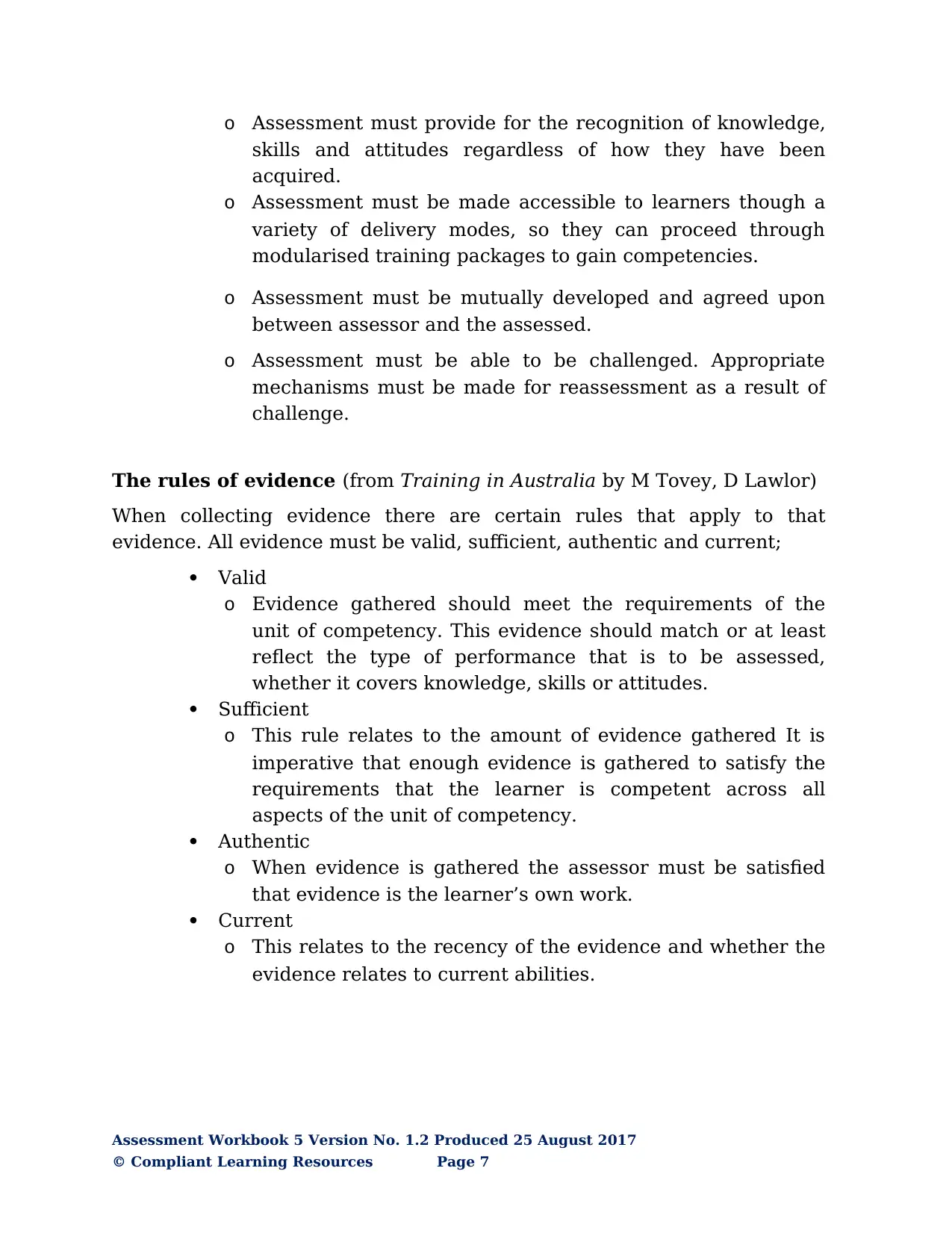
o Assessment must provide for the recognition of knowledge,
skills and attitudes regardless of how they have been
acquired.
o Assessment must be made accessible to learners though a
variety of delivery modes, so they can proceed through
modularised training packages to gain competencies.
o Assessment must be mutually developed and agreed upon
between assessor and the assessed.
o Assessment must be able to be challenged. Appropriate
mechanisms must be made for reassessment as a result of
challenge.
The rules of evidence (from Training in Australia by M Tovey, D Lawlor)
When collecting evidence there are certain rules that apply to that
evidence. All evidence must be valid, sufficient, authentic and current;
Valid
o Evidence gathered should meet the requirements of the
unit of competency. This evidence should match or at least
reflect the type of performance that is to be assessed,
whether it covers knowledge, skills or attitudes.
Sufficient
o This rule relates to the amount of evidence gathered It is
imperative that enough evidence is gathered to satisfy the
requirements that the learner is competent across all
aspects of the unit of competency.
Authentic
o When evidence is gathered the assessor must be satisfied
that evidence is the learner’s own work.
Current
o This relates to the recency of the evidence and whether the
evidence relates to current abilities.
Assessment Workbook 5 Version No. 1.2 Produced 25 August 2017
© Compliant Learning Resources Page 7
skills and attitudes regardless of how they have been
acquired.
o Assessment must be made accessible to learners though a
variety of delivery modes, so they can proceed through
modularised training packages to gain competencies.
o Assessment must be mutually developed and agreed upon
between assessor and the assessed.
o Assessment must be able to be challenged. Appropriate
mechanisms must be made for reassessment as a result of
challenge.
The rules of evidence (from Training in Australia by M Tovey, D Lawlor)
When collecting evidence there are certain rules that apply to that
evidence. All evidence must be valid, sufficient, authentic and current;
Valid
o Evidence gathered should meet the requirements of the
unit of competency. This evidence should match or at least
reflect the type of performance that is to be assessed,
whether it covers knowledge, skills or attitudes.
Sufficient
o This rule relates to the amount of evidence gathered It is
imperative that enough evidence is gathered to satisfy the
requirements that the learner is competent across all
aspects of the unit of competency.
Authentic
o When evidence is gathered the assessor must be satisfied
that evidence is the learner’s own work.
Current
o This relates to the recency of the evidence and whether the
evidence relates to current abilities.
Assessment Workbook 5 Version No. 1.2 Produced 25 August 2017
© Compliant Learning Resources Page 7
Paraphrase This Document
Need a fresh take? Get an instant paraphrase of this document with our AI Paraphraser
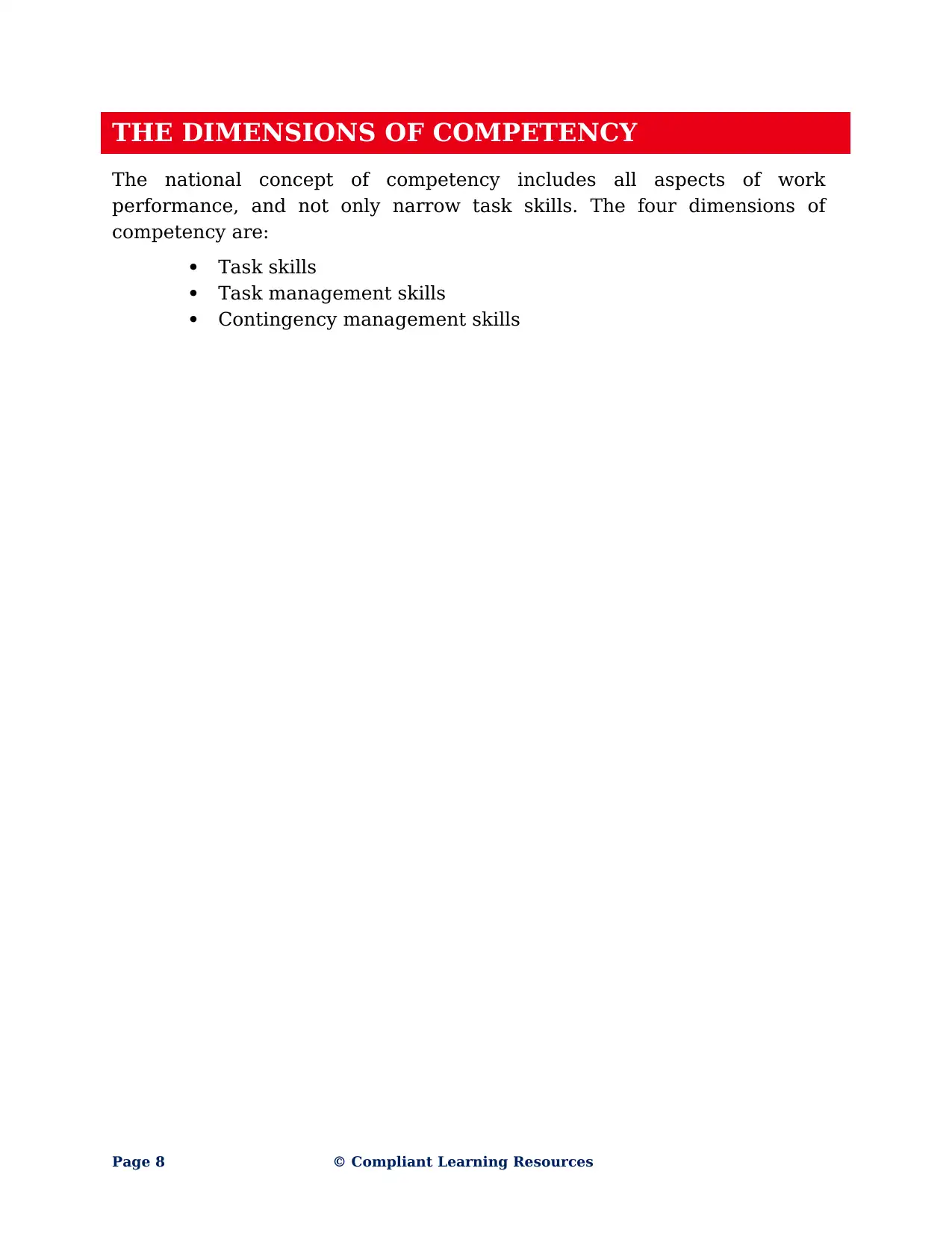
THE DIMENSIONS OF COMPETENCY
The national concept of competency includes all aspects of work
performance, and not only narrow task skills. The four dimensions of
competency are:
Task skills
Task management skills
Contingency management skills
Page 8 © Compliant Learning Resources
The national concept of competency includes all aspects of work
performance, and not only narrow task skills. The four dimensions of
competency are:
Task skills
Task management skills
Contingency management skills
Page 8 © Compliant Learning Resources
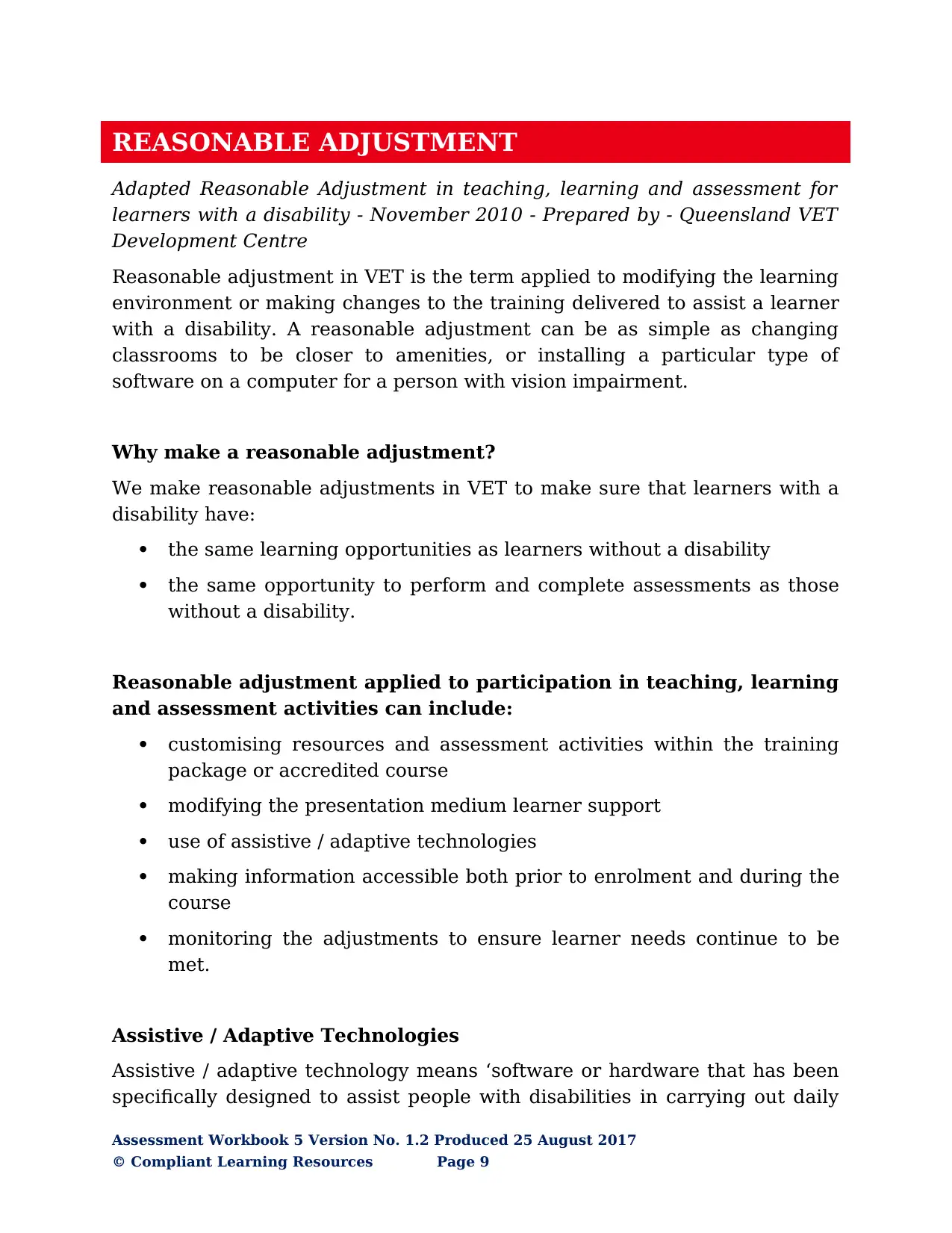
REASONABLE ADJUSTMENT
Adapted Reasonable Adjustment in teaching, learning and assessment for
learners with a disability - November 2010 - Prepared by - Queensland VET
Development Centre
Reasonable adjustment in VET is the term applied to modifying the learning
environment or making changes to the training delivered to assist a learner
with a disability. A reasonable adjustment can be as simple as changing
classrooms to be closer to amenities, or installing a particular type of
software on a computer for a person with vision impairment.
Why make a reasonable adjustment?
We make reasonable adjustments in VET to make sure that learners with a
disability have:
the same learning opportunities as learners without a disability
the same opportunity to perform and complete assessments as those
without a disability.
Reasonable adjustment applied to participation in teaching, learning
and assessment activities can include:
customising resources and assessment activities within the training
package or accredited course
modifying the presentation medium learner support
use of assistive / adaptive technologies
making information accessible both prior to enrolment and during the
course
monitoring the adjustments to ensure learner needs continue to be
met.
Assistive / Adaptive Technologies
Assistive / adaptive technology means ‘software or hardware that has been
specifically designed to assist people with disabilities in carrying out daily
Assessment Workbook 5 Version No. 1.2 Produced 25 August 2017
© Compliant Learning Resources Page 9
Adapted Reasonable Adjustment in teaching, learning and assessment for
learners with a disability - November 2010 - Prepared by - Queensland VET
Development Centre
Reasonable adjustment in VET is the term applied to modifying the learning
environment or making changes to the training delivered to assist a learner
with a disability. A reasonable adjustment can be as simple as changing
classrooms to be closer to amenities, or installing a particular type of
software on a computer for a person with vision impairment.
Why make a reasonable adjustment?
We make reasonable adjustments in VET to make sure that learners with a
disability have:
the same learning opportunities as learners without a disability
the same opportunity to perform and complete assessments as those
without a disability.
Reasonable adjustment applied to participation in teaching, learning
and assessment activities can include:
customising resources and assessment activities within the training
package or accredited course
modifying the presentation medium learner support
use of assistive / adaptive technologies
making information accessible both prior to enrolment and during the
course
monitoring the adjustments to ensure learner needs continue to be
met.
Assistive / Adaptive Technologies
Assistive / adaptive technology means ‘software or hardware that has been
specifically designed to assist people with disabilities in carrying out daily
Assessment Workbook 5 Version No. 1.2 Produced 25 August 2017
© Compliant Learning Resources Page 9
⊘ This is a preview!⊘
Do you want full access?
Subscribe today to unlock all pages.

Trusted by 1+ million students worldwide
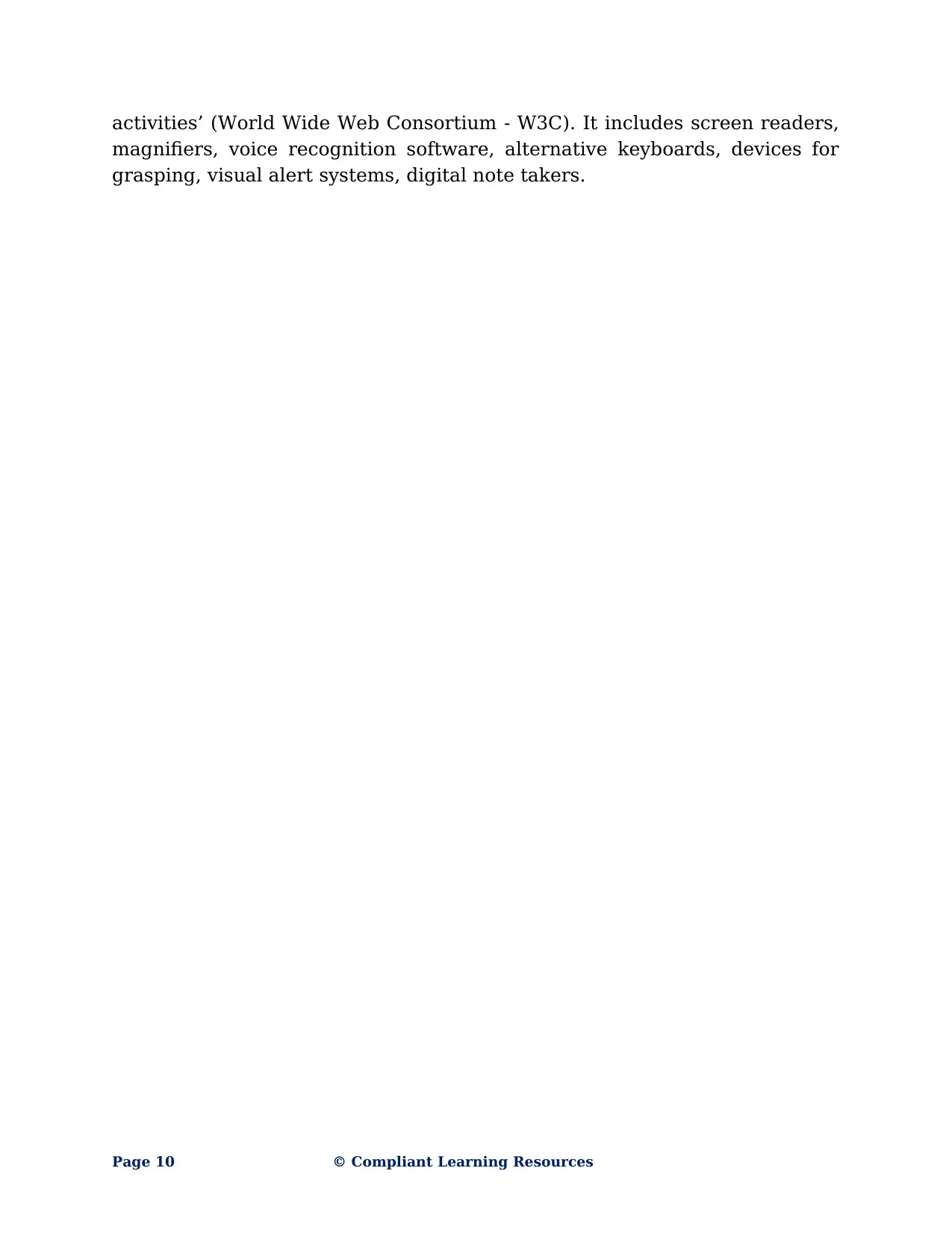
activities’ (World Wide Web Consortium - W3C). It includes screen readers,
magnifiers, voice recognition software, alternative keyboards, devices for
grasping, visual alert systems, digital note takers.
Page 10 © Compliant Learning Resources
magnifiers, voice recognition software, alternative keyboards, devices for
grasping, visual alert systems, digital note takers.
Page 10 © Compliant Learning Resources
Paraphrase This Document
Need a fresh take? Get an instant paraphrase of this document with our AI Paraphraser
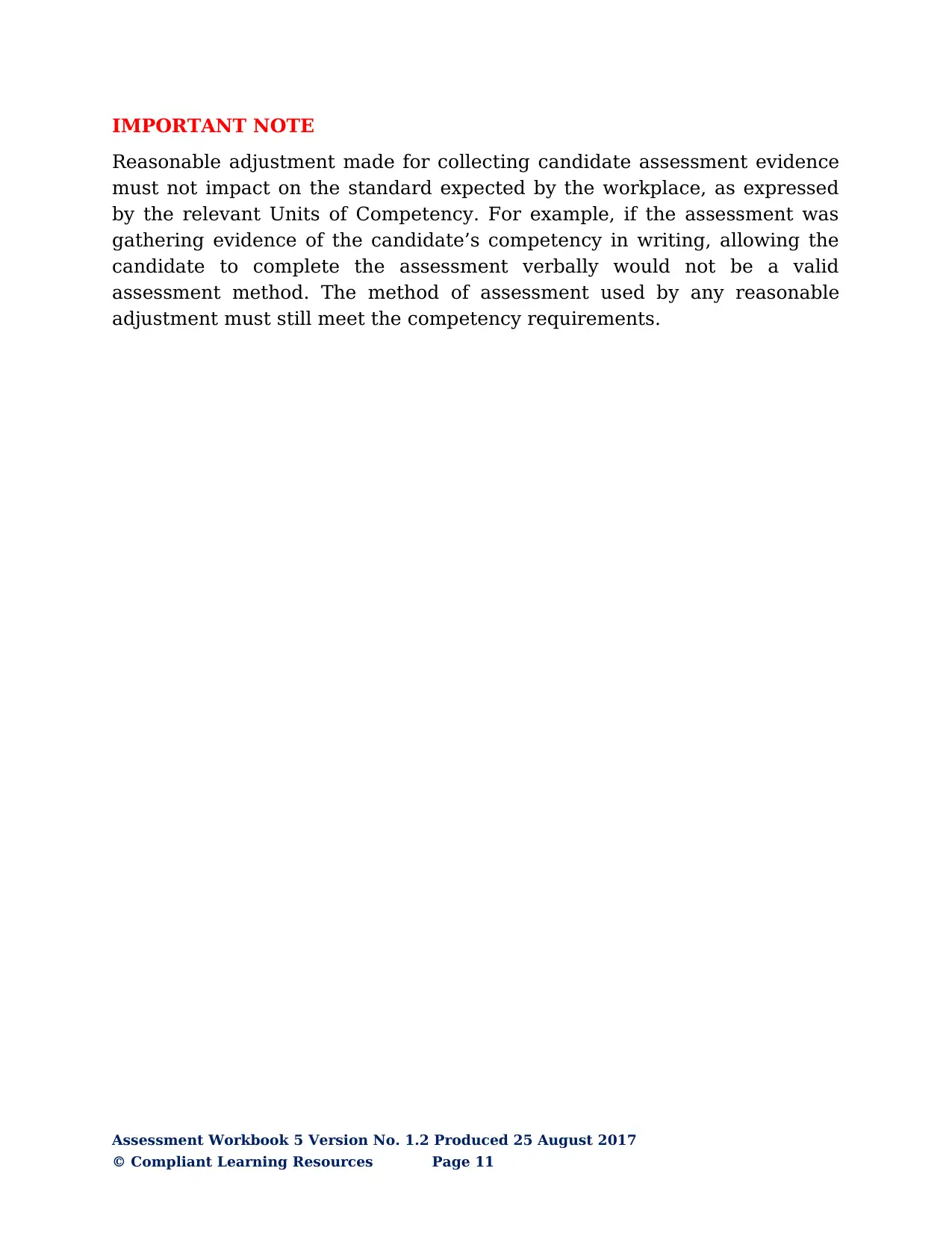
IMPORTANT NOTE
Reasonable adjustment made for collecting candidate assessment evidence
must not impact on the standard expected by the workplace, as expressed
by the relevant Units of Competency. For example, if the assessment was
gathering evidence of the candidate’s competency in writing, allowing the
candidate to complete the assessment verbally would not be a valid
assessment method. The method of assessment used by any reasonable
adjustment must still meet the competency requirements.
Assessment Workbook 5 Version No. 1.2 Produced 25 August 2017
© Compliant Learning Resources Page 11
Reasonable adjustment made for collecting candidate assessment evidence
must not impact on the standard expected by the workplace, as expressed
by the relevant Units of Competency. For example, if the assessment was
gathering evidence of the candidate’s competency in writing, allowing the
candidate to complete the assessment verbally would not be a valid
assessment method. The method of assessment used by any reasonable
adjustment must still meet the competency requirements.
Assessment Workbook 5 Version No. 1.2 Produced 25 August 2017
© Compliant Learning Resources Page 11
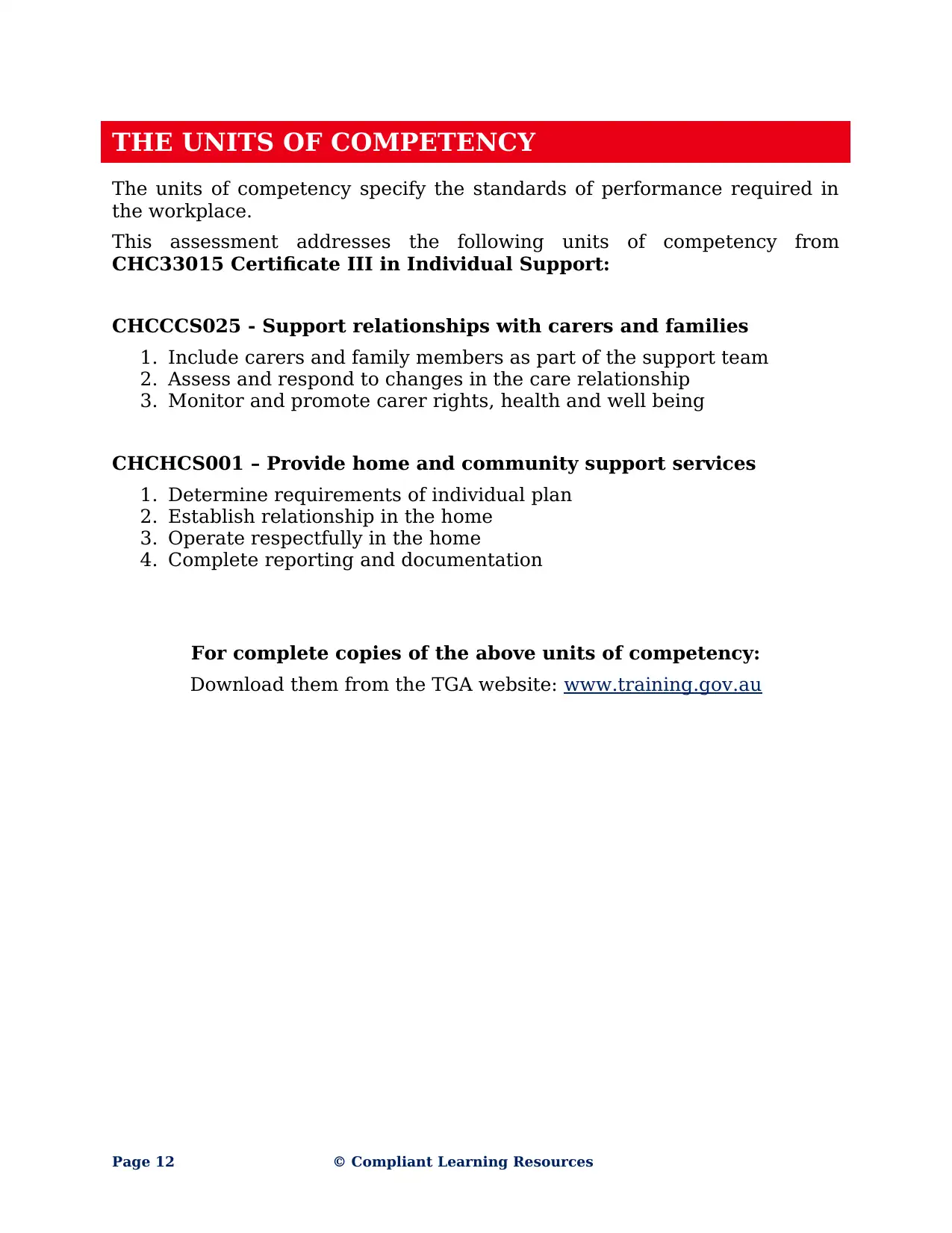
THE UNITS OF COMPETENCY
The units of competency specify the standards of performance required in
the workplace.
This assessment addresses the following units of competency from
CHC33015 Certificate III in Individual Support:
CHCCCS025 - Support relationships with carers and families
1. Include carers and family members as part of the support team
2. Assess and respond to changes in the care relationship
3. Monitor and promote carer rights, health and well being
CHCHCS001 – Provide home and community support services
1. Determine requirements of individual plan
2. Establish relationship in the home
3. Operate respectfully in the home
4. Complete reporting and documentation
For complete copies of the above units of competency:
Download them from the TGA website: www.training.gov.au
Page 12 © Compliant Learning Resources
The units of competency specify the standards of performance required in
the workplace.
This assessment addresses the following units of competency from
CHC33015 Certificate III in Individual Support:
CHCCCS025 - Support relationships with carers and families
1. Include carers and family members as part of the support team
2. Assess and respond to changes in the care relationship
3. Monitor and promote carer rights, health and well being
CHCHCS001 – Provide home and community support services
1. Determine requirements of individual plan
2. Establish relationship in the home
3. Operate respectfully in the home
4. Complete reporting and documentation
For complete copies of the above units of competency:
Download them from the TGA website: www.training.gov.au
Page 12 © Compliant Learning Resources
⊘ This is a preview!⊘
Do you want full access?
Subscribe today to unlock all pages.

Trusted by 1+ million students worldwide
1 out of 48
Related Documents
Your All-in-One AI-Powered Toolkit for Academic Success.
+13062052269
info@desklib.com
Available 24*7 on WhatsApp / Email
![[object Object]](/_next/static/media/star-bottom.7253800d.svg)
Unlock your academic potential
Copyright © 2020–2025 A2Z Services. All Rights Reserved. Developed and managed by ZUCOL.





